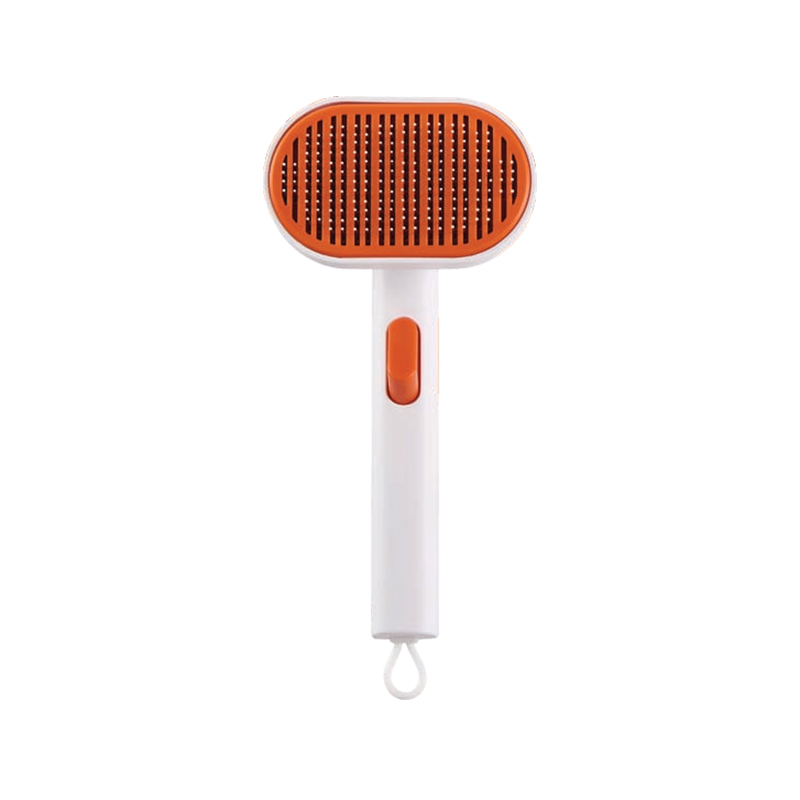In the field of pet care tools, the role of Pet Hair Remover Comb Manufacturer is particularly critical. In the process of pet hair care, they not only need to provide effective hair management solutions, but also ensure the comfort and durability of the tools during use. The balance between material selection, design philosophy, and safety standards directly impacts the product's ultimate performance. For industry professionals, understanding the relationship between material properties and design principles helps them make more informed purchasing decisions. Consumers, on the other hand, can discern key design details to choose care tools that truly suit their pets' needs. By continuously optimizing product details, pet hair removal comb manufacturers are driving the entire industry towards a more professional and humane direction.
How does material choice affect the performance and lifespan of a comb?
Material is the fundamental factor that determines the performance and lifespan of a pet comb. Pet hair removal comb manufacturers usually make comprehensive considerations from three aspects: teeth, handle and internal structure.
- The gear parts are mostly made of rust-resistant metal with appropriate hardness. For example, polished stainless steel can keep the tooth tips smooth to avoid snagging hair, and can also maintain stability when exposed to water or detergents for a long time. Some models also have an elastic coating added to the base of the teeth to cushion the pressure on your pet's skin during combing.
- The handle material directly impacts the grip. Common solutions include injection-molded high-strength plastics and rubber with a non-slip textured surface. This type of material not only reduces overall weight but also ensures stable operation in wet environments. For professional grooming situations involving extended periods, fatigue resistance is particularly important when selecting the handle material.
- The material of the internal connectors is also crucial. For example, if the spring mechanism is made of carbon steel with rust-proof treatment, the service life of the adjustable component can be extended. From a commercial perspective, a reasonable material ratio can not only control production costs, but also reduce the frequency of after-sales maintenance through durability.
Some manufacturers have tried to add anti-static coatings to the surface of the comb teeth to reduce static electricity that may be generated when combing in a dry environment, thereby improving the pet experience. Such innovations not only enhance product functionality but also extend the tool's lifespan.
How does the geometry of the teeth change combing efficiency?
Tooth shape design is the core technology area for pet hair removal comb manufacturers. Different tooth pitches, lengths, and profile angles are suitable for various hair textures and thicknesses. The wide-pitch comb teeth are ideal for initial detangling and are designed to reduce pulling resistance. These teeth typically feature a tapered tip and rounded corners to ensure they don't break hair when detangling. The fine-pitch version focuses on capturing scattered floating hairs, and the teeth need to maintain uniform spacing to avoid excessive entrainment of healthy hairs.
For pets with double coats, some manufacturers have developed a staggered arrangement of long and short teeth. Long teeth penetrate the topcoat to reach the undercoat, while short teeth simultaneously comb the outer coat. This design allows multiple levels of care to be completed in a single pass, reducing the discomfort your pet would experience from repeated grooming.
Reasonable geometric shape design can not only improve the efficiency of single combing, but also extend the service life of the product. This is because the friction loss between the comb teeth and the hair is reduced, allowing the tool to maintain its original performance for longer.
Why is ergonomic design so important in daily grooming?
Ergonomic design directly impacts the user's operating experience and the comfort of the pet. The shape and weight distribution of the tool's handle directly affect the user's hand fatigue and operating accuracy. Pet hair removal comb manufacturers continuously optimize the curvature and friction coefficient of the handle through biomechanical research.
Common ergonomic solutions include a three-point support handle: a tail flange prevents slippage during operation, a middle finger groove encourages a natural grip, and a forefoot support area distributes pressure. This type of design is particularly suitable for areas that require delicate manipulation, such as a pet's abdomen or around joints.
Weight balance is also crucial. Setting the center of gravity of the comb close to the palm can reduce the burden on the wrist. Some professional models also incorporate weights within the handle to adjust weight distribution for a more effortless combing motion.
Ergonomic tools also reduce your pet's discomfort during the grooming process. A comb that is easy to control allows for smoother and gentler movements, reducing the likelihood of the pet resisting due to tension. Some designs further optimize the user experience by balancing weight distribution and increasing cushioning areas. This attention to detail helps transform daily grooming into a pleasant, interactive activity.
Why are materials and coatings that reduce static electricity important?
Static electricity in dry environments can increase hair tangles and discomfort, particularly for long-haired breeds. Using antistatic materials or applying antistatic coatings to metal and plastic surfaces can reduce static electricity buildup, making hair easier to separate and collect. Such coatings need to be wear-resistant, able to maintain their functionality through repeated rubbing and cleaning, and not release harmful substances. For manufacturers, developing antistatic solutions can not only improve comfort during use, but also achieve differentiated positioning and added value in specific markets.

How to implement safety mechanism in comb design?
Safety is a core element of pet comb design, and its implementation encompasses multiple dimensions, including tip treatment, structural strength, and emergency protection. The comb teeth should have rounded contact ends to prevent scratches; the tooth spacing design must take into account the avoidance of skin wrinkles and sensitive areas; the connectors and screw points should adopt anti-loosening structures or mechanical locking to prevent parts from falling off. For tools containing blades, blade guards and depth limits are necessary to control the risk of misuse. Furthermore, tooth spacing must be carefully calculated to ensure effective capture of loose hair without pinching or pulling on the pet's hair follicles.
Durability is also closely linked to safety. Combs made of stable materials and reliable assembly processes are less likely to have loose or broken parts, thus reducing potential risks. Some products are also equipped with additional safety mechanisms, such as locking designs to prevent accidental operation, to cope with various usage scenarios.
How do manufacturers strike a balance between effectiveness and comfort?
Balancing effectiveness and comfort requires comprehensive consideration of tooth layout, material hardness, and overall construction. The tooth arrangement should be tailored to different hair types: wider teeth are suitable for initial detangling, while finer teeth capture fine hair and debris. The flexibility of the teeth is also important; teeth with a certain degree of flexibility can better conform to the pet's body curves and reduce localized pressure.
Furthermore, some designs integrate multiple functions, such as combing teeth and depilatory blades, allowing users to complete different steps without having to change tools. This improves efficiency and reduces pet anxiety. By optimizing the combing rhythm and reducing operation time, pet combs can achieve results while maintaining a high level of comfort.
What materials make combs durable and animal-friendly?
In addition to stainless steel, some combs utilize silicone or rubber, materials that are gentle on pet skin and provide a certain cushioning effect. High-performance plastics are often used for handles and comb frames due to their light weight and high strength, making them suitable for daily use. In addition, the use of recyclable materials is gradually increasing, responding to the market demand for environmentally friendly products.
The choice of materials also needs to consider the ease of cleaning and maintenance. Designs that are easy to disassemble and wash help users maintain tool hygiene, extending their lifespan.
How do innovations in surfaces and bristles change the scope of tool use?
In recent years, some manufacturers have experimented with adding special textures or coatings to comb surfaces to enhance their ability to absorb hair. For example, the rubber bristles can effectively capture pet hair scattered on fabrics, expanding the tool's usage scenarios. In addition, replaceable brush heads or modular designs allow users to adjust the comb function according to specific needs, improving the flexibility and practicality of the product.
Such innovations not only meet diverse market demands, but also provide manufacturers with differentiated competitive advantages. By continuously optimizing product design, pet hair removal comb manufacturers are better able to adapt to evolving consumer preferences.
Which type of comb is recommended for different coat types?
For short, single-coated breeds, brushes with a micro-textured rubber or silicone surface can remove loose hair without irritating the skin. Breeds with double coats or dense undercoats require longer, more rigid teeth to reach the undercoat. Severely tangled coats are best served with tools with segmented teeth or cutter guards to detangle in stages and reduce tugging. In professional scenarios, a set of tools is provided to cover different steps from initial combing to fine-tuning, allowing beauticians to improve work efficiency and reduce pet discomfort.
Tallfly, a dedicated provider of pet grooming tools, is committed to integrating engineering expertise with user needs. By continuously optimizing materials, design, and safety, Tallfly offers a range of products suitable for both home and professional use. Its meticulous attention to detail ensures reliable and comfortable tools in real-world use. If you are looking for solutions that can improve care efficiency and pet experience, Tallfly is willing to provide you with further product information and cooperation support.
 English
English 中文简体
中文简体 русский
русский

